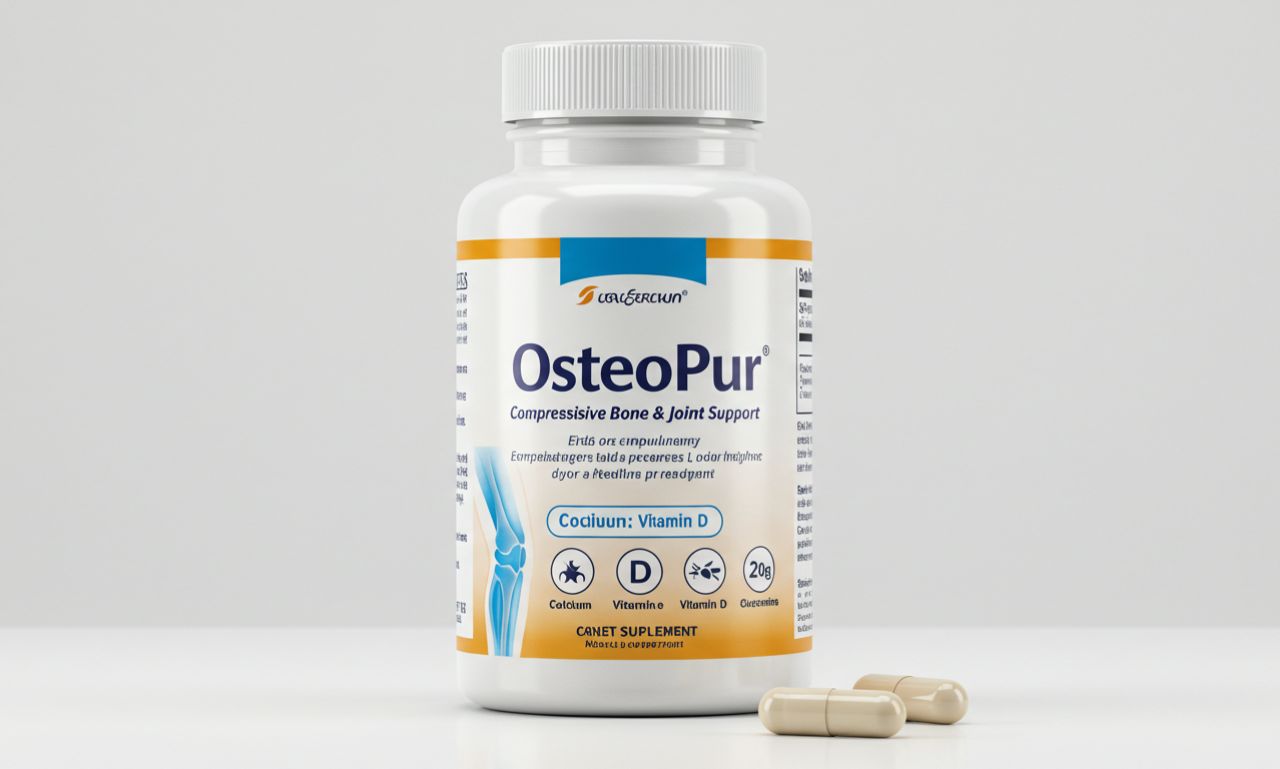
In an age when many health supplements make grand promises, Osteopur tries to stand out by being a “complete bone and joint support” formula rather than just another calcium pill. In this article, we’ll explore what Osteopur claims to be, how it works, its benefits, potential risks, and how to evaluate whether it might be right for you.
Osteopur – what is it exactly?
Osteopur is marketed as a multi-nutrient dietary supplement focused on improving bone strength and joint function. Rather than relying on a single ingredient (like calcium), it combines a suite of vitamins, minerals, and co-factors intended to work synergistically to support skeletal health.
The idea is that bone metabolism is complex: minerals must be absorbed, directed properly into bone tissue (not soft tissues), and muscle / joint structures around bones also need support. Osteopur’s formulation attempts to address all those aspects in a single supplement.
Because Osteopur appears in listings like NICAPUR Osteopur Complex Capsules (eBay listing) it seems some versions are produced under brand names with standard capsule forms.
Osteopur – key ingredients and how they work
To evaluate any supplement, the ingredients and their dosages matter more than the name. Here are the main components often cited in Osteopur formulations, and what they bring to the table:
Calcium (often as citrate or hydroxyapatite)
Calcium is the foundational mineral for bone. Osteopur typically uses more bioavailable forms like calcium citrate or microcrystalline hydroxyapatite instead of plain calcium carbonate. These forms may be absorbed better in individuals with reduced stomach acid.
Vitamin D3 (cholecalciferol)
Vitamin D3 plays a central role in facilitating calcium absorption from the intestines into the bloodstream. Without adequate vitamin D, taking calcium may be less effective. Many bone health strategies emphasize D3 for this reason.
Vitamin K2 (often MK-7 form)
Vitamin K2 acts as a “traffic director” for calcium, helping it be deposited into bones rather than soft tissues and arteries. It helps activate the protein osteocalcin, which binds calcium into bone matrices.
Magnesium
Magnesium is important for bone metabolism, helping convert vitamin D into its active form, and aiding in the structural integrity of bone matrix. A magnesium deficiency may hamper bone health even if calcium intake is adequate.
Trace minerals & co-factors (e.g. boron, zinc, manganese)
Some versions of Osteopur include trace minerals like boron, zinc, manganese, and possibly others. These act as supporting cast: helping enzyme systems involved in bone remodeling, hormone balance, and collagen synthesis.
Optional collagen or joint-support ingredients
While not always included, some formulations or promotional descriptions mention collagen peptides or herbal anti-inflammatory herbs to support joints and cartilage. However, these are not universally confirmed in all Osteopur versions.
Osteopur – claimed benefits & expected results
What users and promoters often claim Osteopur can help with:
-
Improved bone density / strength over time, reducing risk of fractures.
-
Better calcium absorption and utilization, thanks to the D3, magnesium, K2 synergy.
-
Reduced risk of soft-tissue calcification, by helping direct calcium to bones rather than arteries, thanks to K2.
-
Joint support / flexibility via trace minerals or collagen (in versions that include them).
-
General skeletal wellness, especially for aging adults, postmenopausal women, or those at risk of bone loss.
Because bone remodeling is a slow process, noticeable improvements in bone mineral density may take months to a year or more. Surveys and summaries of ingredient research suggest that sustained supplementation combined with lifestyle changes is key.
Osteopur – who may benefit, who should be cautious
Who might benefit:
-
Middle-aged or older adults, especially after age 40, when bone resorption begins to outpace formation.
-
Postmenopausal women, who often face accelerated bone loss due to reduced estrogen.
-
People with low dietary calcium, vitamin D, or mineral intake, or who have absorption issues.
-
Individuals recovering from bone injury or fracture, though under physician guidance.
-
Physically active people / athletes whose bones and joints endure extra stress.
Who should be cautious or avoid:
-
Individuals with kidney disease or kidney stones: excess calcium or mineral supplementation must be handled carefully.
-
People on anticoagulant / blood-thinning medications (e.g. warfarin): Vitamin K2 can interfere with such medications.
-
Those with hypercalcemia or disorders of calcium metabolism.
-
Pregnant or nursing women should consult a provider before using.
-
People allergic to any ingredient (rare, but possible).
As with any supplement, it’s wise to consult your healthcare provider before starting Osteopur, especially if you have underlying medical conditions or take other medications.
Osteopur – how to use it (dosage, timing, best practices)
While specific dosages depend on the branded formulation you buy, here are general guidelines and best practices based on similar multi-nutrient bone formulas:
-
Take with meals, especially ones containing fat, because fat helps absorption of fat-soluble vitamins (like D3 and K2).
-
Divide doses if the product requires more than one serving per day, to improve absorption.
-
Consistent use is crucial—don’t skip days. Bone metabolism is a gradual process.
-
Pair with diet & exercise: supplements support, not replace, adequate dietary calcium, protein, vitamin D, and weight-bearing exercise.
-
Monitor labs: Regular checks of calcium, vitamin D status, kidney function, and bone density (if possible) can guide long-term use.
-
Stay within safe upper limits: Don’t exceed recommended dosages for calcium, vitamin D, etc., because excess intake can cause negative effects.
Always consult your provider or a registered dietitian to tailor the dosage to your health context.
Osteopur – safety, side effects & interactions
Generally, multi-nutrient bone supplements like Osteopur are well-tolerated when used as directed. However, potential issues to watch:
-
Gastrointestinal discomfort: bloating, gas, constipation or mild nausea—often mitigated by taking with food.
-
Hypercalcemia risk if combined with other high-dose calcium supplements or excessive dietary sources.
-
Kidney burden: especially with impaired renal function, excess minerals may stress kidneys.
-
Mineral interactions: Some minerals compete for absorption (e.g. calcium vs magnesium vs zinc), so balanced formulas matter.
-
Drug interactions: Vitamin K2 can reduce effectiveness of blood thinners. Calcium may interfere with absorption of certain antibiotics or thyroid medications if taken simultaneously.
-
Allergic or intolerance reactions depending on excipients or capsule materials.
To stay safe, always review the label, avoid duplicating with other supplements, and consult a healthcare professional before starting.
Osteopur – how it compares to typical bone supplements
Many basic bone supplements consist of just calcium + D3, which addresses only part of the equation. Osteopur aims to be more advanced by including co-factors:
-
Better absorption: Inclusion of magnesium, citrate forms, and D3 can improve uptake.
-
Better targeting: Vitamin K2 helps direct calcium to bone, reducing arterial calcification risk.
-
Comprehensive support: Trace minerals and optional joint-support components give a more holistic formula.
-
Risk mitigation: Because it tries to balance nutrients, there’s less risk of creating an imbalance from taking one nutrient in isolation.
That said, brand formulations differ, and the proof is in third-party testing, transparent labeling, and clinical data. A well-formulated Osteopur product must compete with high-quality competitors or prescription options depending on your bone health status.
Osteopur – real user impressions and evidence
Because Osteopur is less widely known than major supplement brands, peer-reviewed clinical trials specific to “Osteopur” are not widely documented online (based on searches). Most of the evidence cited comes from the known effects of its ingredients in scientific literature (e.g., D3 + K2 + magnesium + calcium) rather than brand-specific trials.
User reviews in supplement forums and blogs often mention:
-
Gradual improvements in joint comfort and flexibility.
-
A sense of reassurance regarding bone health, particularly for those undergoing bone density scans.
-
Some minor digestive complaints early on, which often resolve.
But these are anecdotal. Anyone interested in tracking actual bone density improvements should use medical imaging (DEXA scan) over time to assess whether a supplement regime is making measurable changes.
Osteopur – tips to maximize benefits
To get the most out of Osteopur (or similar bone supplements), consider combining with lifestyle factors:
-
Weight-bearing exercise: walking, dancing, resistance training stimulate bone formation.
-
Adequate protein intake: bones require amino acids and collagen building blocks.
-
Sunlight or safe UV exposure: helps your body synthesize natural vitamin D.
-
Avoid smoking and limit alcohol: both accelerate bone loss.
-
Maintain a balanced diet: leafy greens, dairy or fortified alternatives, nuts/seeds, and whole foods.
-
Ensure gut health: probiotics, fiber, and digestive support optimize mineral absorption.
-
Regular monitoring: periodic lab tests and bone scans help you adjust dosage or supplement choices.
Supplements are supportive, not a substitute for healthy habits.
Conclusion
Osteopur presents itself as a more comprehensive and intelligent approach to bone and joint support than simple calcium pills. Its blend of calcium (in absorbable form), D3, K2, magnesium, and trace minerals aligns with modern understanding of bone metabolism. The rationale behind the formulation is sound, based on what is known from nutrition science.
That said, it is not a miracle cure, and its effectiveness will depend on consistent, long-term use plus supporting lifestyle measures. Because brand-specific clinical trials are scarce, users should approach it as one piece of a broader bone health plan—not a standalone guarantee.






